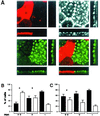PDZ-domain interactions and apical expression of type IIa Na/P(i) cotransporters
- PMID: 12192091
- PMCID: PMC129376
- DOI: 10.1073/pnas.182412699
PDZ-domain interactions and apical expression of type IIa Na/P(i) cotransporters
Abstract
Type IIa Na/P(i) cotransporters are expressed in renal proximal brush border and are the major determinants of inorganic phosphate (P(i)) reabsorption. Their carboxyl-terminal tail contains information for apical expression, and interacts by means of its three terminal amino acids with several PSD95/DglA/ZO-1-like domain (PDZ)-containing proteins. Two of these proteins, NaPi-Cap1 and Na/H exchanger-regulatory factor 1 (NHERF1), colocalize with the cotransporter in the proximal brush border. We used opossum kidney cells to test the hypothesis of a potential role of PDZ-interactions on the apical expression of the cotransporter. We found that opossum kidney cells contain NaPi-Cap1 and NHERF1 mRNAs. For NHERF1, an apical location of the protein could be documented; this location probably reflects interaction with the cytoskeleton by means of the MERM-binding domain. Overexpression of PDZ domains involved in interaction with the cotransporter (PDZ-1/NHERF1 and PDZ-3/NaPi-Cap1) had a dominant-negative effect, disturbing the apical expression of the cotransporter without affecting the actin cytoskeleton or the basolateral expression of Na/K-ATPase. These data suggest an involvement of PDZ-interactions on the apical expression of type IIa cotransporters.
Figures








References
-
- Murer H, Kaissling B, Forster I, Biber J. In: The Kidney: Physiology and Pathophysiology. 3rd Ed. Seldin D W, Giebish G, editors. Philadelphia: Lippincott; 2000.
-
- Murer H, Hernando N, Forster I, Biber J. Physiol Rev. 2000;80:1373–1409. - PubMed
-
- Custer M, Lötscher M, Biber J, Murer H, Kaissling B. Am J Physiol. 1994;35:F767–F774. - PubMed
-
- Ritthaler T, Traebert M, Lötscher M, Biber J, Murer H, Kaissling B. Kidney Int. 1999;55:976–983. - PubMed
Publication types
MeSH terms
Substances
LinkOut - more resources
Full Text Sources
Research Materials
Miscellaneous

